Mousegunner's MAK-90

This web page presents information and photographs I have compiled and edited from various sources. It is still a "work in progress." I have freely borrowed photos from all over the web, as well as using my own. If one of these photos is yours, and you want your name on it, or if you want it removed, please E-mail. At the end of this page you will find internet links to a variety of informative AK-47 web sites.
Mousegunner's MAK-90
Mikhail Timofeevich Kalashnikov is the most famous living gun designer in the world, and his machine gun, the AK-47, is the most famous gun in the world. He was born on November 10, 1919, in the village of Kurya, in Alma-Ata, in Kazakhstan, to a large peasant family. Mikhail was the seventeenth child of Timofel and Alexandra Kalashnikov. When seven years old he entered the normal Soviet "Ten Year School." After finishing school, young Mikhail became an apprentice and soon after a technical secretary in the Turkistan-Siberian railway department. In 1938 He was drafted to serve his country in the Red Army. He began his military service in Kiev in the tank corp.
Kalashnikov was a natural born tinkerer and inventor. During his early months in the army, he became interested in small arms. His commanding officer recognized an eager and inventive intelligence, and recommended Kalashnikov for a technical course that would qualify him as an armorer once he had completed his basic training. As a result, Kalashnikov attended the training school for tank drivers. While he was there, he designed and built a device to measure the tank's fuel consumption. He also designed an improved track assembly for tanks, and an inertia revolution counter to register the number of shots from a tank gun, as well as other tank related inventions.
Kalashnikov was promoted to sergeant in 1939, and sent to Leningrad by his commander-in-chief General G.K. Zhukov to oversee production of his fuel gauge and track assemblies.
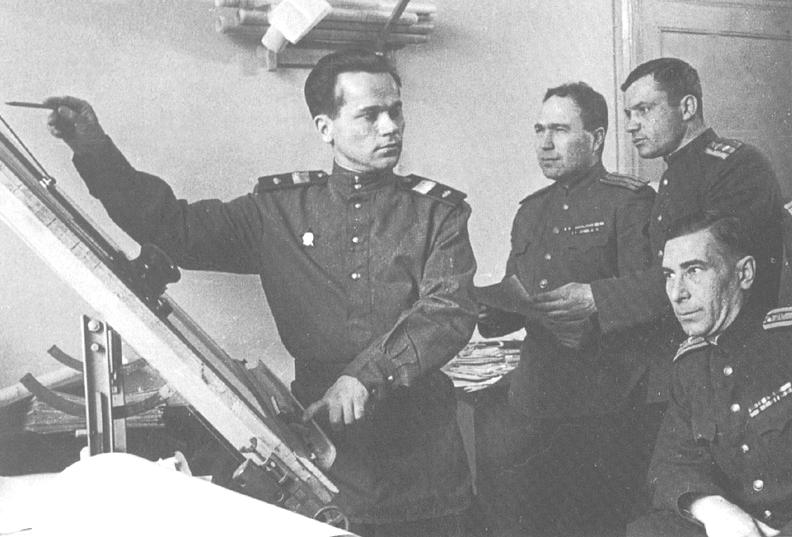
When Germany invaded the Soviet Union on June 22, 1941 he became a Red Army Senior Sergeant, and went to the front lines, where he served as a tank commander. In September, during the battle for Bryansk, his vehicle was struck by an explosive round, and Kalashnikov was badly wounded in the shoulder, and was hospitalized.
During World War II, the Germans had developed the assault rifle, based upon research that showed that most fire-fights happened within a range of less than 300 yards. The rifle cartridges in use at the time were larger and heavier that what was really needed for most battles. As a result, armies sought a cartridge and rifle combining high capacity magazines, automatic fire and an intermediate-power cartridge.
The resultant rifle, the German Sturmgewehr 44 (StG44) was not the first with these features; its predecessors were the Italian Cei-Rigotti and the Russian Fedorov Avtomat design rifles. The Germans, however, were the first to produce and field sufficient numbers of this assault rifle to properly evaluate its combat utility.
Stg44 Photo from UziTalk.com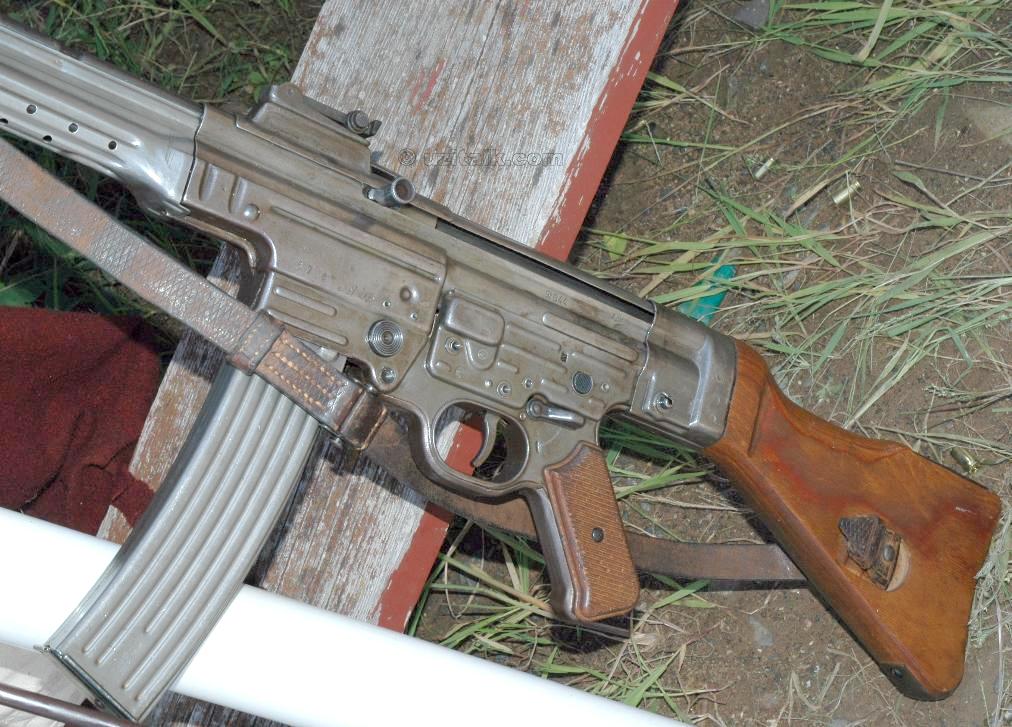
("Sturmgewehr" was the origination of the term "Assault Rifle.") Towards the end of the war, they fielded the weapon against the Soviets. This experience deeply influenced both Kalashnikov as an individual, and Soviet military doctrine in the post-war years.
German soldier with StG44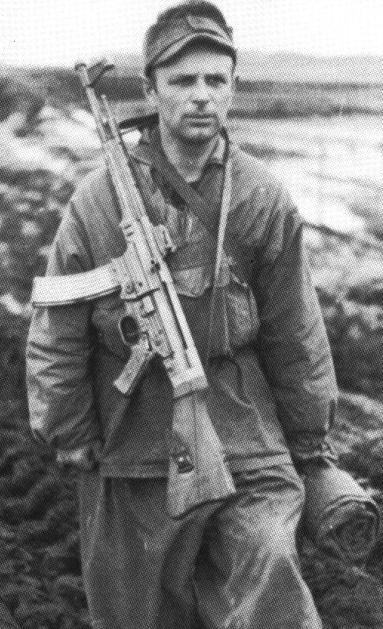
While in the hospital, recovering, Kalashnikov began to dream of a new Soviet firearm, which would match or even improve on the German weapons. In the hospital library he found V.G. Fedorov's basic weapons textbook, Evolution of Small Arms. Kalashnikov later wrote: "That was my lucky day. The book by Vladimir Federov proved to be invaluable. It gave me my first insight into the principles of developing automatic firearms, and put me straight on the positive and negative aspects of each class of firearms."
Mikhail Kalashnikov says his rifle was not based on the German StG44 assault rifle. But the AK-47 represents a combination of previous rifle innovations: the double locking lugs and unlocking raceway of the M1 Garand/M1 carbine; the trigger and safety mechanism of the Browning Remington Model 8 rifle; and the gas system and layout of the German StG44. The main advantages of the Kalashnikov rifle are simple design and adaptation to mass production. It is a melding of the best the Garand, Browning, and StG44 features.
M1 Garand Rifle
Kalashnikov had ready access to the StG44, and he experimented with similar concepts, but he threw out many details of the StG44: The two-part receiver (something that the M16 has), the clumsy return mechanism (, another something the M16 shares with the StG44), the tilting bolt, the gas piston, the left-side safety lever and charging handle, the tight part fittings. The StG44 had the right concept, but Kalashnikov found out in his development that many of the details were wrong.
Granted a six month rest leave, Kalashnikov went home to Alma-Ata, which was also the new location of the Moscow Aviation Institute. There he visited friends in the railway technical section, and convinced one of them, Zhenya Kravchenko to let him use the depot's machine tools to continue his design work. After three months, Kalashnikov produced a working design. He then went out to find a Communist party official to sponsor his work.
For a chronological illustrated history of the AK, go to
http://kalashnikov.guns.ru/history.html.and go to...
http://browningmgs.com/T2T3/Kalashnikov.htm
After many interviews, Kalashnikov met the Secretary of the Central Committee of the Communist Party of Kazakhstan. While the Secretary was not a firearms expert, he believed that there might be some merit to the design. As a result, he arranged for Kalashnikov to continue development of his sub-machine gun at the near-by Moscow Aviation Institute (MAI). Kalashnikov continued to refine his design, and it was eventually sent to the Dzerzhinskiy Artillery Academy for testing and evaluation.
Kalashnikov's firearm came to the attention of General Anatoly Arkadaevich Blagonravov, the Chairman of Infantry Weapons at the Dzerzhinskiy Artillery Academy. He decided to provide Kalashnikov with a formal engineering education. Kalashnikov never rejoined the military, but became a technician at the proving ground at Ensk. While at Ensk Kalashnikov attracted further attention through his work on modifications to Goryunov machineguns. These modifications brought him two "author's certificates," the closest thing the Soviet Union had to patents. It was also at Ensk that Kalashnikov first came into contact with leading firearm designers Degtyarev, Simonov, and Sudayev.
Kalashnikov, posing in front of the Order of Lenin, and other medals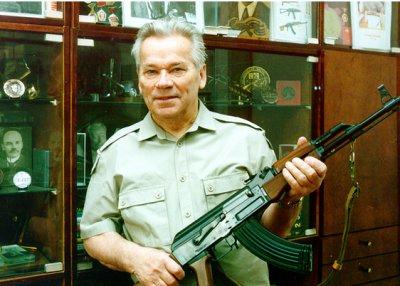
Kalashnikov changed his design in 1944 to match the newer 7.62x39mm cartridges. He developed a selective fire carbine that used a rotating bolt operated by a cam lug moving in a groove in the bolt carrier. It had a fixed magazine, like the SKS, but it used many features which would later re-appear in the AK47. Kalashnikov's project died when the SKS was adopted by the Soviet Army as their semi-automatic battle rifle.
SKS Soviet Battle Rifle (Yugoslavian Model)
Kalashnikov's competitor, A.I. Sudayev, submitted a very different 7.62x39mm automatic rifle in early 1944. It was a blowback operated gun using a massive bolt. Tests indicated that the gun would quickly shoot itself to pieces, and that further development was needed. Sudayev then submitted a second design that incorporated a rotating bolt mechanism (like Kalashnikov's design) and a folding butt. Tests indicated that the gun was still too heavy, and the Artillery Committee of the Main Artillery Commission issued requirements for decreasing the weight.
Enlargement of a 7.62x39 cartridge on top of a 20-round ammo box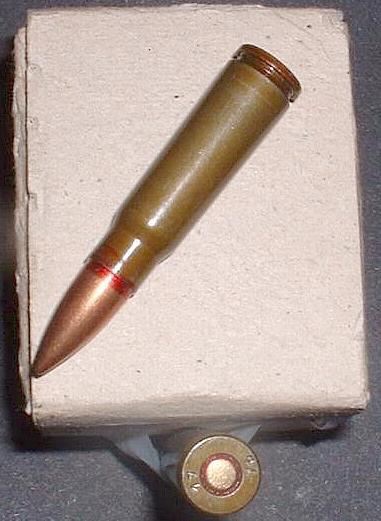
Kalashnikov was studying the weapons of the other designers while developing his own weapon. Kalashnikov produced his "Mikhtim" (derived from his first name and patronymic). He settled on the use of a gas operated mechanism, and in the Spring of 1946 he submitted his latest rifle for evaluation by the Main Artillery Commission, and won acceptance after it was dragged through mud, sand, and dust and was still able to fire without jamming. Moscow authorities accepted his design for development as an experimental weapon. Kalashnikov created a design team which included A.A. Zaytsev, Engineer-Colonel V.S. Demin, V.V. Krupin, V.A. Kharkov, A.D. Kryakushkin, N.N. Afanasyev, and V.N. Punshin, and tests continued.
By 1949 the "Avtomat Kalashnikova" had been accepted as the standard carbine of the Soviet Army, capping four years of design, engineering work and testing. Production of the AK47 began late in 1949. When released from military service in 1949, Kalashnikov was assigned to the Izhevsk Machine Factory as a civilian engineer, where he quickly became a senior manager, overseeing production engineering and design operations. Kalishnikov and his team then perfected a new and lighter stamped receiver for the AK.
Mikhail Kalashnikov with a more modern AK-74 (easily identified by the grove on the butt stock)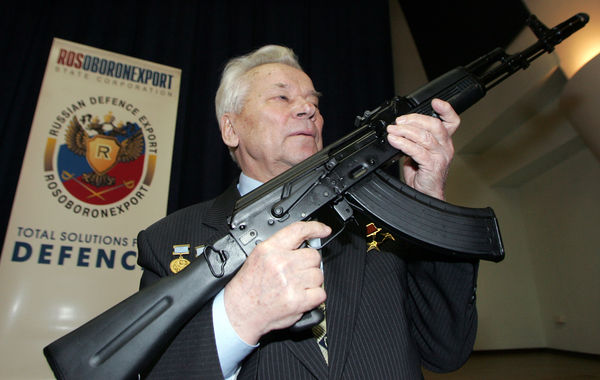
There were many setbacks during early production. The first models had stamped sheet metal receivers. Difficulties were encountered in welding the guide and ejector rails, causing high rejection rates. Instead of halting production, a heavy machined receiver was substituted for the sheet metal receiver. This was a more costly process, but the use of machined receivers accelerated production as tooling and labor for the earlier Mosin-Nagant rifle's machined receiver were easily adapted. Partly because of these problems, the Soviets were not able to distribute large numbers of the new rifle to soldiers until 1956. During this time, production of the interim SKS rifle continued.
Early model milled receiver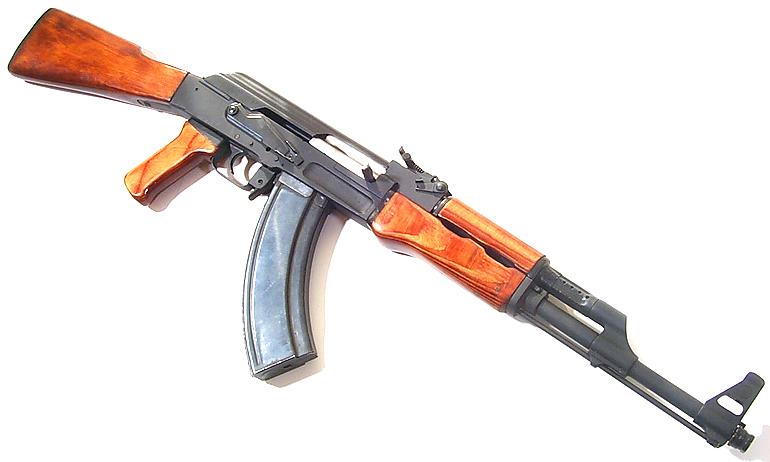
Once manufacturing difficulties had been overcome, a redesigned version designated the AKM (Avtomat Kalashnikova Modernizirovanniy) was introduced in 1959. This new model reverted to an improved stamped sheet metal receiver, and featured a slanted muzzle brake on the end of the barrel to compensate for muzzle rise under recoil. In addition, a hammer retarder was added to prevent the weapon from firing out of battery (without the bolt being fully closed), during rapid or automatic fire. This is also sometimes referred to as a "cyclic rate reducer", or simply "rate reducer", as it also has the effect of reducing the number of rounds fired per minute during automatic fire. It was also lighter than the previous model, at roughly one-third lighter.
Early model milled receiver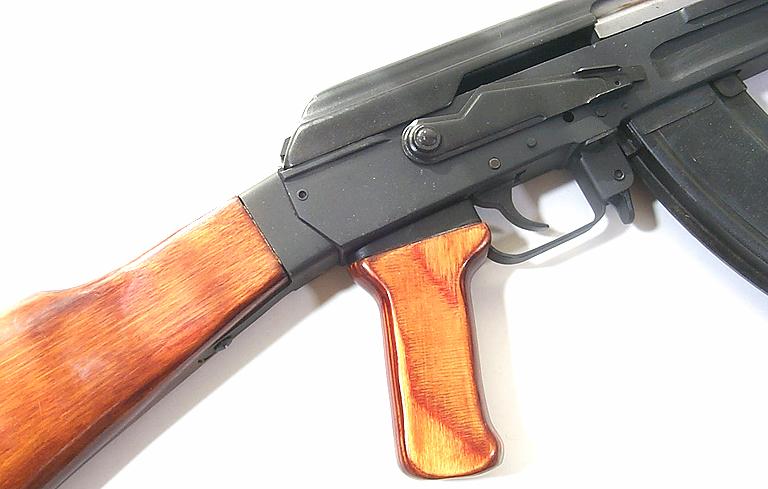
Between 1950 and 1970, a series of unified small arms weapons developed by Kalashnikov-AKM, AKMS, AK-74, AKS-74, AK-74U, RPK, RPRS, RPK-74, RPKS-74, PK, PKS, PKM, PKSM, PKT, PKTM, PKB, PKMB-were adopted.
Milled receiver - 1954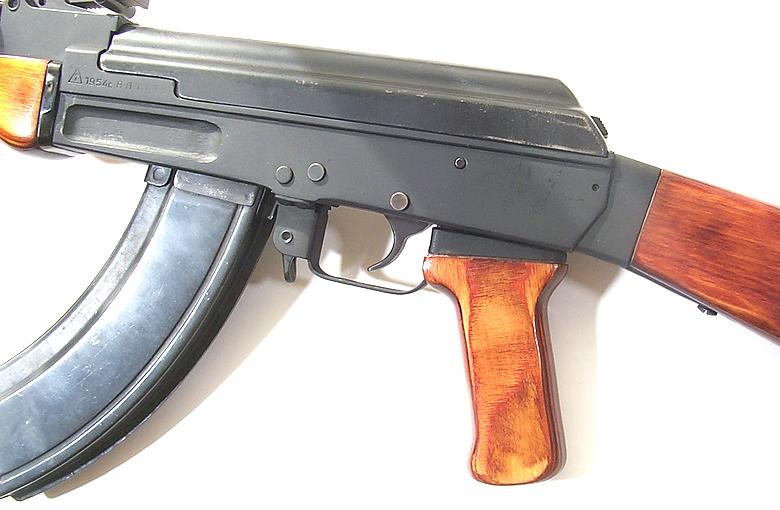
In 1978, the Soviet Union began replacing their AK-47 and AKM rifles with a newer design, the AK-74. This new rifle and cartridge had only started being exported to eastern European nations when the Soviet Union collapsed, drastically slowing production of this and other weapons of the former Soviet bloc.
Another AK-74 (note the identifying groove in the stock)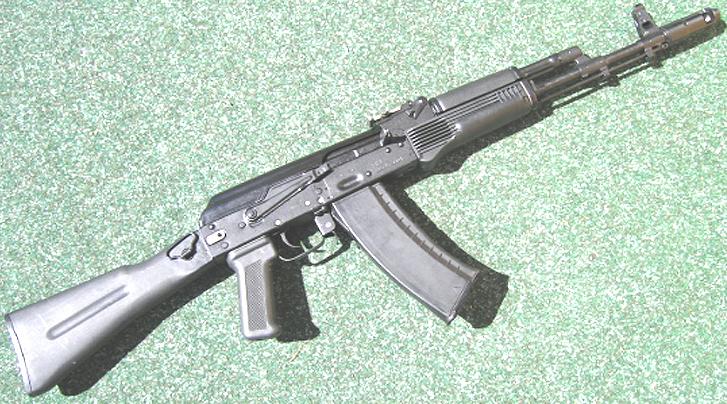
The standard AK-47 or AKM fires a 7.62x39mm round with a muzzle velocity of 710 metres per second (2,329 ft/s). Muzzle energy is 2,010 joules (1,467 ft·lbf). Cartridge case length is 38.6 millimetres (1.5 in), weight is 18.21 grams (281.0 gr). Projectile weight is normally 8 grams (123 gr). The AK-47 and AKM, with the 7.62x39mm cartridge, have a maximum effective range of around 300-400 meters.
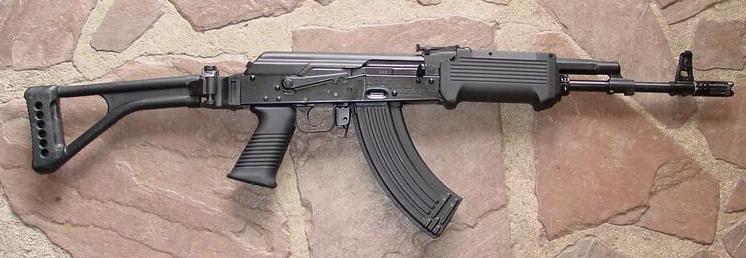
The AK-74 was basically a re-chambered AKM variant modified to take the newer 5.45 x 39 mm calibre ammunition, the Russian equivalent to the standard 5.56 x 45 mm NATO standard round. The full metal-jacketed bullet designed for this weapon has a copper-plated steel jacket and a largely steel core, as does the bullet of its predecessor, the AK-47.
AK-74 Ammo (5.45 x 39 mm)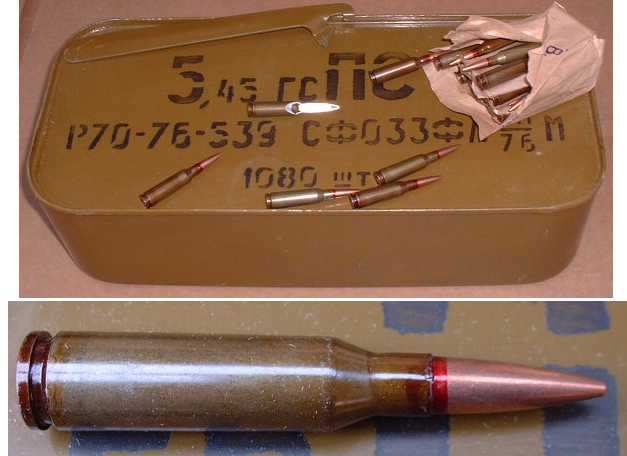
A unique design feature of the AK-74, however, is an air-space (about 5mm long) inside the jacket at the bullet's tip. The speculation that this air-space would cause bullet deformation and fragmentation on impact proved to be unfounded, but the air-space does serve to shift the builet's centre of mass toward the rear, possibly contributing to its very early yaw.
The receiver of an AK-74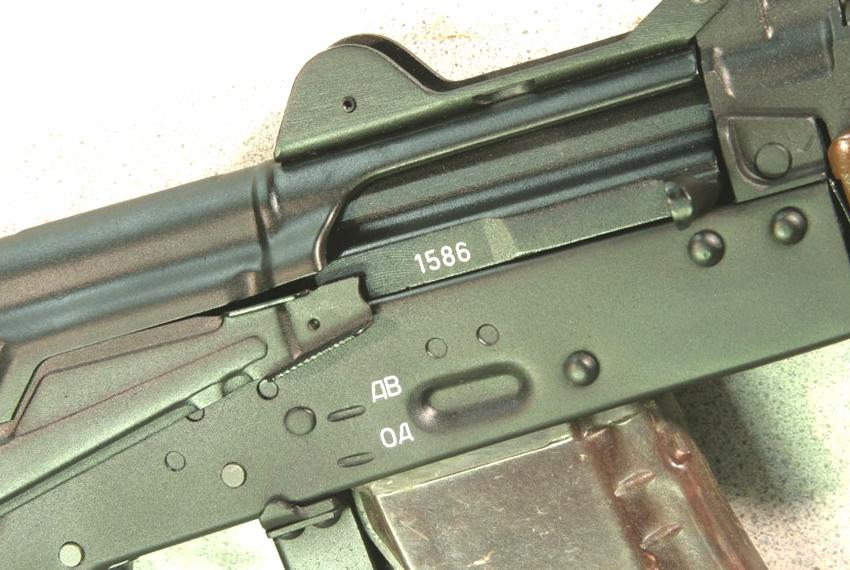
In addition, on bullet impact with tissue, the lead just behind the air-space shifts forward into this space. This shift of lead occurs asymmetrically and may be one reason for the peculiar curvature of this bullet's path in the last half of its path through tissue. Only in a shot with a long tissue path, like an oblique shot through the torso, would this curved path be evident; it doesn't really add anything to wounding capacity, but might cause an occasional confusing path through tissue. This bullet yaws after only about 7cm of tissue penetration, assuring an increased temporary cavity stretch disruption in a higher percentage of extremity hits; other bullets need more tissue depth to yaw and in many cases cause only minimal disruption on extremity hits.
Kalashnikov has been honored often by the Soviet and Russian governments. In 1948 he was given the Stalin Prize for Industrial Work. In 1949 he became a Hero of Socialist Labor. He was granted membership in the Communist Party of the Soviet Union in 1953 and was selected to serve on the budgetary planning commission for the Soviet Union. In 1966 he was elected to serve as a Deputy of the Supreme Soviet. And in 1971 the title of Doctor of Technical Sciences was conferred upon him - a Soviet variant on the concept of knighthood.
Kalashnikov in Soviet Uniform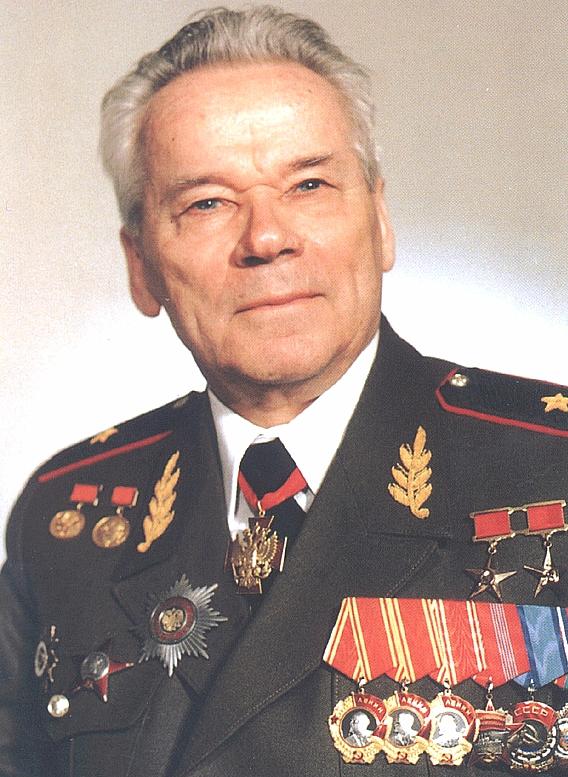
Along with Colt, Browning and Stoner, Kalashnikov stands among the foremost designers of firearms in the world. His influence over small arms development dominated much of the twentieth century and will most likely continue well into the twenty-first. In 1980 Kalashnikov was especially honored by his native village of Kurya. His bronze bust was placed there, and in 1987 he also became an honorary citizen of Izhevsk.
Boris Yeltsin and Mikhail Kalashnikov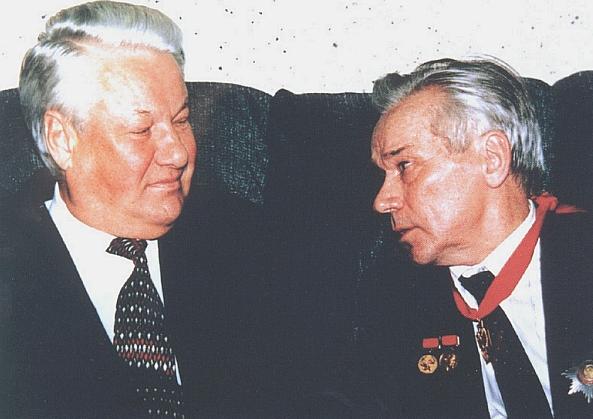
Boris Yeltsin, personally decorated Kalashnikov with the Order "For Distinguished Services for the Motherland" Second Class, and promoted him to Major-General on his 75th birthday in 1994. Despite estimates of some 100 million AK-47 assault rifles circulating (as of 2007), General Kalashnikov has not profited financially from arms sales.
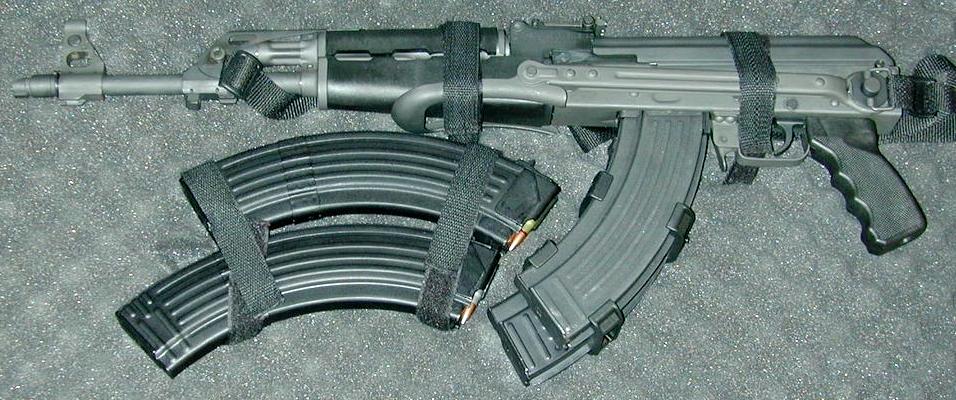
The AK is simple, inexpensive to manufacture and easy to clean and maintain. Its ruggedness and reliability are legendary. The large gas piston, generous clearances between moving parts, and tapered cartridge case design allow the gun to endure large amounts of foreign matter and fouling without failing to cycle. This reliability comes at the cost of accuracy, as the looser tolerances do not allow the precision and consistency that are required of more accurate firearms. Reflecting Soviet infantry doctrine of its time, the rifle is meant to be part of massed infantry fire, not long range engagements.
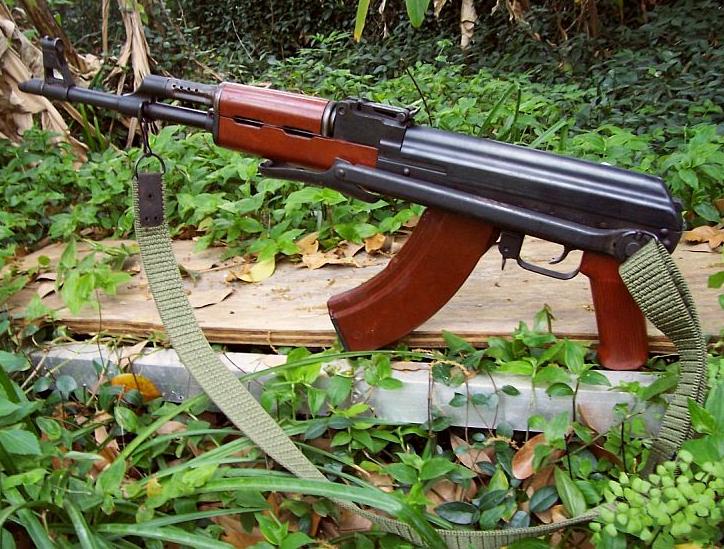
The notched rear tangent iron sight is adjustable, and is calibrated in hundreds of meters. The front sight is a post adjustable for elevation in the field. Windage adjustment is done by the armory before issue. The battle setting places the round within a few centimeters above or below the point of aim out to about 250 meters (275 yd). This "point-blank range" setting allows the shooter to fire the gun at any close target without adjusting the sights. Longer settings are intended for area suppression. These settings mirror the Mosin-Nagant and SKS rifles which the AK-47 replaced. This eased transition and simplified training.
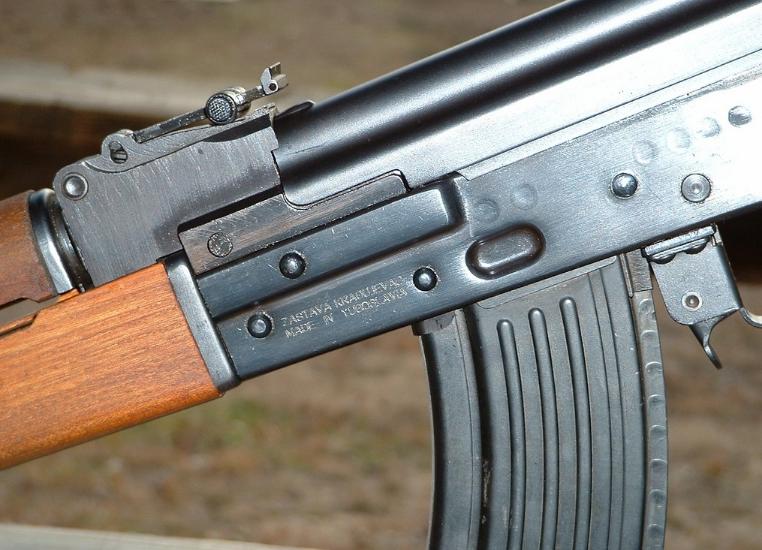
The automatic weapons of the Kalashnikov system are widely used the world over. Since 1990, after the breakup of the USSR and Socialis Federal Republic of Yugoslavia, the Kalashnikov small arms have been extensively or partially operational in the armies, used by special-task forces or manufactured for export to the following countries: Albania, Azerbaijan, Algeria, Armenia, Angola, Afghanistan, Bangladesh, Belarus, Benin, Bulgaria, Bolivia, Bosnia, and Herzegovina, Botswana, Hungary, Vietnam, Gabon, Ghana, Guatemala, Guinea, Guinea - Bissau, Haiti, Gambia, Guyana, Honduras, Georgia, Djibouti, Egypt, Zaire, Zambia, Zimbabwe, North Yemen, South Yemen, Israel, India, Indonesia, Jordan, Iraq, Iran, Italy, Kazakhstan, Campuchia, Cape Verde, China, Qatar, Colombia, Comoros, Congo, North Korea, Cuba, Kyrgyzstan, Laos, Latvia, Lesotho, Lebanon, Lybia, Lithuania, Mauritania, Madagascar, Macedonia, Mali, Maldives, Malta, Morocco, Mozambique, Moldova, Namibia, Nigeria, the Netherlands, Nicaragua, United Arab Emirates, Pakistan, Peru, Poland, Portugal, Russia, Romania, Swaziland, Sao Tome and Principe, Seychelles, Slovakia, Slavonia, Syria, Somali, Sudan, Surinam, Sierra Leone, Tajikistan. Tanzania, Togo, Trinidad and Tobago, Tunisia, Turkmenistan, Uganda, Uzbekistan, Ukraine, the Philippines, Finland, Croatia, Czechia, Sweden, Sri Lanka, Equatorial Guinea, Estonia, Ethiopia, South Africa and Yugoslavia.
This is one of the popular Romanian WASR10 AKs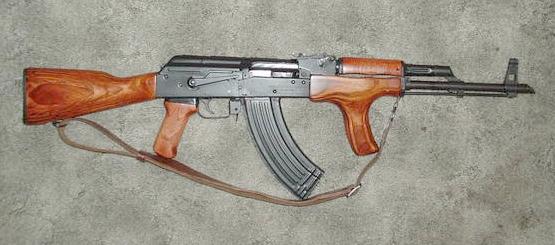
According to various sources, about 70 million Kalashnikov assault rifles of various modifications were manufactured by the middle of 1990, both in the USA and abroad, including those made under license and others without permission. Their number has risen to perhaps 100 million by the present time (2008).
Russia marks AK-47's 60th birthday (ABC News Article - 2006)
With his shock of white hair, brown sandals and hearing aid, the designer of the world's deadliest assault rifle took a philosophical outlook as he celebrated his invention's 60th anniversary on Friday. "It was the Germans who turned me into an arms designer," Mikhail Kalashnikov, 87, said at celebrations in Moscow of the 60th anniversary of the creation of his AK-47 automatic rifle. "If I hadn't taken part in the war, I would probably have made technology to ease the tough work of the peasants," said Mr Kalashnikov, who grew up in a peasant family in the remote Altai mountain region by the Mongolian border. Instead, he created a rifle that has become an iconic brand, as symbolic of Russia as vodka and fur coats, and the weapon of choice of guerrillas and dozens of armies around the world. Mr Kalashnikov started working on his rifle in 1947, driven to design by Soviet defeats in the early years of World War II at the hands of far better-armed German soldiers. The Kalashnikov quickly became prized for its sturdy reliability in difficult field conditions. It can also be built relatively easily - "in any workshop," he said. More than 100 million Kalashnikov rifles have now been sold worldwide.
Russia’s Trademark Gun, but Others Grab Profits, by C. J. CHIVERS (New York Times, 2007)
The automatic Kalashnikov, the world’s most abundant firearm and a martial symbol with a multiplicity of meanings, turns 60 this year. In some places this is cause to shudder. In Russia it is treated as a milestone to celebrate, and a chance to cry foul.
Once strictly Communist products, the AK-47 and its offspring are killing tools so durable and easy to use that they were heralded as achievements of state socialism and industrial might. Uncoupled from the laws of supply and demand by their origins in planned economies, they flowed from arms plants in the tens of millions, becoming national defense and foreign policy instruments for the Soviet Union and allied states.
A beautiful AK-74 (note the identifying groove in the stock)
But the 60th birthday party has displayed the rifle’s evolving place in both the market and the Kremlin’s mind. These days the Kalashnikov is seen through capitalist lenses, and argued about in ways that could not possibly have been envisioned by its Communist creators.
In cash-hungry Russia, Kalashnikov is now an informal brand. And as purchases of Kalashnikov rifles and their derivatives continue on foreign markets, Russian arms manufacturers and exporters worry not about ideology and world dominance, but over sales opportunities lost.
The back story manages to be both odd and unsurprising. Russia’s anger is at the United States, a potential customer that has become, once again, a premier distributor, handing out the weapons to indigenous police officers and soldiers in Afghanistan and Iraq. The United States was also a bulk purchaser in the 1980s, when it supplied mostly Chinese and Egyptian Kalashnikovs to anti-Soviet insurgents in Afghanistan.
In returning to the Kalashnikov market, the Pentagon has shunned purchases from Russia, opting instead for AK-47 knockoffs available for sale or donation from other countries’ stockpiles. (The true AK-47 was short lived and swiftly modified; its many variants, almost all of which the Soviet Union helped create via foreign aid, are often inaccurately called AK-47s, by now universal shorthand.)
In Afghanistan, the United States has selected the AMD-65, a short-barreled Hungarian Kalashnikov copy with a forward hand grip and futuristic muzzle, as the standard weapon of the Afghan police. It has received most of its projected 55,600 AMD-65s via its foreign military sales programs, according to data provided by Combined Security Transition Command-Afghanistan.
The next photo shows a Hungarian AMD with a side-folding stock, and a Yugo with an underfolder. These fine firearms belong to Carlos, and the photo is used with his permission.
Another 10,000 Kalashnikov knockoffs were transferred in 2006 to Afghanistan from Slovenia. At least some weapons being handed out, based on an examination of the shipping containers and rifles this spring in Afghanistan, are inexpensive Chinese clones.
Similarly, in Iraq (which once had its own Kalashnikov plant, built with Communist help) the United States scrounged or purchased more than 185,000 Kalashnikov-style rifles and light machine guns for Iraqi security forces from 2003 and 2006, according to the special inspector general for Iraq reconstruction.
Golden AKs of Saddam Hussein
It did so without buying a single weapon from Russia, which, as creator of the underlying design that all automatic Kalashnikovs share, regards itself as the rightful owner of an informal but global brand. These transfers have alarmed and irritated Russian officials and arms merchants, and split the AK-47’s 60th birthday celebrations between parties and bitter pleas.
With events that began in early July and will continue into August, the Kremlin and its arms-export agency are feting both a family of weapons and the man credited with their creation, Mikhail T. Kalashnikov, who at 87 has proved to be as durable as the rifles that bear his name.
Even General Kalashnikov himself is venting his dismay over proliferation without Russian profit. "I take them into my hands and, my goodness, the marks are foreign," he said of the knockoffs the Soviet Union once championed. "Yes, they look alike. But as to reliability and durability - they do not meet the high standards of our military."
Without these controversies, the celebrations might have had a familiar feel. The AK-47 and its derivatives, first tested in the forests outside of Moscow six decades ago, have been common on battlefields and in Soviet and revolutionary iconography for two generations. General Kalashnikov long ago became a hero of the proletariat.
The photo below shows a Romanian AK-74 with a Russian 8x42 scope. This firearm belongs to Carlos, and is used with his permission. Carlos has since changed the front sight to an AK-74 sight, and installed a real AK-74 muzzle brake.
By the fall of the Soviet Union, their global saturation was complete. Soviet students practiced assembling and disassembling Kalashnikovs in the 10th grade. Soviet statues clutched them with muscular, thick-handed grips. Almost anyone who might fight the West or its partners had been eligible for automatic rifle shipments from the Communist bloc, or even a rifle or ammunition plant.
The testimonials this month have celebrated Russia’s version of this history. Depending on your point of view, these rifles have been either a revolutionary’s trusted partner or a lethal instrument of proxy war, terror and crime. The chosen speakers, hand-picked by Russian officials, have chosen the former line.
Hungarian AMD-65
"On behalf of all my brethren who died in the anti-American war to liberate our country, we thank you for inventing this weapon," Senior Col. To Xuan Hue, the defense attaché from Vietnam, told Mr. Kalashnikov at one celebration.
Group Capt. Biltim Chingono, the defense attaché from Zimbabwe, also sidestepped the rifle’s checkered reputation, saying that in his country’s civil war it had proved "to be the mightier and decisive freedom pen."
In Russian circles, little praise is being spared. "The famous Kalashnikov assault rifle has become not only an example of daring innovative thought but also a symbol of the talent and creative genius of our people," President Vladimir V. Putin said in a decree.
At the same events, Russian officials and arms manufacturers are clamoring over who should be allowed to put Kalashnikov rifles on the market. Some arguments are based on quality, and Russia claims, without offering evidence, that the copies and clones are not as well made as the genuine article. There is some support for this on black markets in Iraq, where the Russian Kalashnikovs often fetch higher prices than their clones, although whether the rifles are better or simply more coveted is not clear. Other arguments are rooted in what the Russians claim is law, as the arms industry insists that the factories that the Kremlin once sponsored, and now are in sovereign, post-Soviet countries, have no right to manufacture or sell items of Soviet design.
"More than 30 foreign companies, private and state based, continue the illegal manufacturing and copying of small arms," said Sergey V. Chemezov, the former K.G.B. officer and confidant of Mr. Putin’s who directs Rosoboronexport, the state arms-marketing agency. "They undermine the reputation of the Kalashnikov."
So far, few customers have paid notice. The largest customer in the market, the United States, has purchased whatever weapons it sees fit, coloring the AK-47’s 60th birthday, like much of Kalashnikov history, with another angry struggle.
"We cannot tolerate the situation when only 10 percent of the Kalashnikovs are manufactured legally," said Sergey V. Lavrov, Russia’s foreign minister. "We cannot stand for this. We must fight."
There are a handful of engineers and designers whose influence in firearms design was seminal and is still keenly felt in the firearms community today. Indeed, it is not inaccurate to say that the design of every successful firearm is nothing more than an adaptation of principles developed by these men. Tremendous debts are owed to men with names like Browning, Nickl, Mauser, Walther, Wesson, Mannlicher, Kalashnikov and Lee.
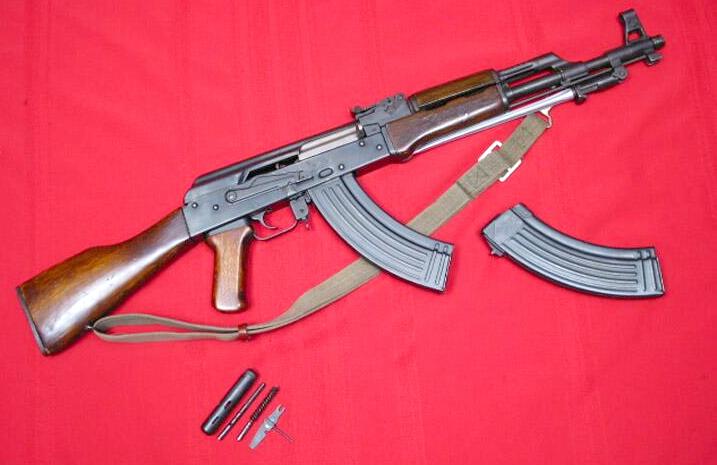
90% of Kalashnikovs Sold Worldwide Are Knockoffs, Charles Ganske (2006 Article)
RIA Novosti reported last week that 90% of the automatic rifles in the world based on Mikhail Kalashnikov's Model 1947 are unlicensed copies, according to the CEO of the Izhmash firm that owns the patent. While this isn't exactly breaking news, as a worldwide cultural phenominon it's interesting because the Kalashnikov "is symbolically reflected in the national coats of arms of six states" (I'm not sure if this estimate includes the flag of Hezbollah, the Shi'a militia that controls southern Lebanon).
To explain why the Kalashnikov is the most successful assault rifle of all time, Nicholas Cage's character in the movie Lord of War describes shooting an AK-47 by saying, "It’s so easy a child can use it. And they do." According to Wikipedia, the nickname for the African boys who carry guns in that continent's numerous regional conflicts is "kalash".
MosNews reports that Venezuela will purchase 100,000 examples of the genuine article.
The common term AK-47 is actually inaccurate (sic). The original AK-47 was milled (machined from bar stock), making it much more expensive to produce. What is commonly referred to as AK-47 today is actually AKM (modernized AK-47) and its clones, which are stamped, a considerably less expensive and faster process.
The rifle is not widespread because "it is simple to use." Most rifles are very simple to use and can be mastered by children. AK's are actually pretty crude weapons. They are not very ergonomic and have poor sights compared to modern Western rifles, making getting hits at long distance more difficult. They are generally inaccurate weapons (sic), having poor barrels, poor metallurgy, and it doesn't help that "Soviet-bloc" ammunition is of low quality in general. Plus as a modern "assault" rifle goes, it is on the heavy side.
NOTE: I (mousegunner) disagree with Mr. Ganske about this. My experience has been that there are many fine AK-47s out there which have good iron sights, and which are capable of good accuracy, even at 200 yards. And there is nothing wrong with USSR metallurgy, and I have had good results with Soviet ammo. Ganske is correct in that an AK-47 is heavier than an AR-15.
On the positive side, it is very robust and reliable, due to the generally sound, simple design and loose fit. It keeps on firing with very little maintenance even in dirty environments. It also breaks down into a few parts quickly without tools. In other words, it makes an ideal weapon for uneducated, ill-supplied peasants who lack basic mechanical aptitude. That just about describe the former Soviet army and its proxies.
NOTE: I (mousegunner) would like to go on record as scolding Mr. Ganske for running down Soviet soldiers in general. I'm no expert on the former Soviet army, however I'm sure that much of it was educated, well-supplied, and not made up of clumsy peasants. It is always unwise to vilify an opponent.
The main reason why it became so widespread is cost. Because the Soviet Union subscribed to the philosophy of "quantity has a quality all to its own," it and its allies produced a massive quantity of these rifles and dumped them on the Third World, making them cheap and disposable.
The photo below (used with permission) shows Carlos' Romanian G-kit.
When given a choice between the two AND cost is not a consideration, most trained professional soldiers generally opt for a variant of the American M-16 over it. For example, when given the choice between the Israeli Galil (updated version of Finnish Valmet, in turn a modernized version of AKM) and the M16/M4, the IDF readily chose the latter, preferring the accuracy and light weight of the latter.
Nonetheless, it is what the professionals call an "adequate" weapon, and considering its superior reliability with low maintenance, is a good rifle to take to rugged areas.
Mikhail Kalashnikov has gone down in the history of small arms as the creator of the world's best assault rifle and also as the designer who was the first in the world to develop and make operational an array of unified automatic small arms models, based on the identical automatic action, design and operating principle. Characteristically, back in the early 1920s, the famous Russian designer V. G. Fedorov, creator of the world's first assault rifle (1916), assisted by young Soviet designers, substantiated theoretically and developed unified experimental models of light automatic machine-guns, aircraft machine-guns, an antiaircraft machine-gun, tank machine-gun and heavy machine-gun based on his assault rifle design. V.G. Fedorov's idea of unifying the automatic small arms was partially implemented in practice by V.A. Degtyarev, who developed two aircraft and one tank machine-gun, based on his DA light machine-gun and the machine-guns that entered service with the Russian Armed Forces.

In the second half of the 20th century, Mikhail Kalashnikov, relying on the achievements of outstanding national designers and advanced technology, made the most use of Fedorov's idea. The unification had beneficial economic and production outcome and expedited the mastering of new types of small arms weapons in the field.
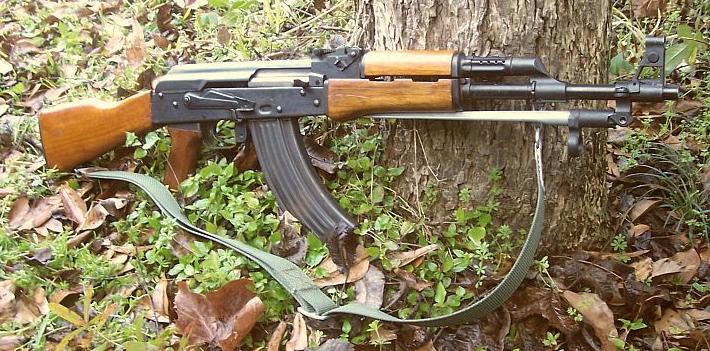
What is behind the unprecedented popularity of the Kalashnikov assault rifle? Mikhail Kalashnikov has obtained an optimum combination of a number of features of the weapon, ensuring its high firing effectiveness and reliability. These include the short locking assembly, balanced bolt, unseating of the cartridge case after shot, preventing failure during extraction of fired cases, insensitivity to contamination and trouble-free operation in any climatic conditions.
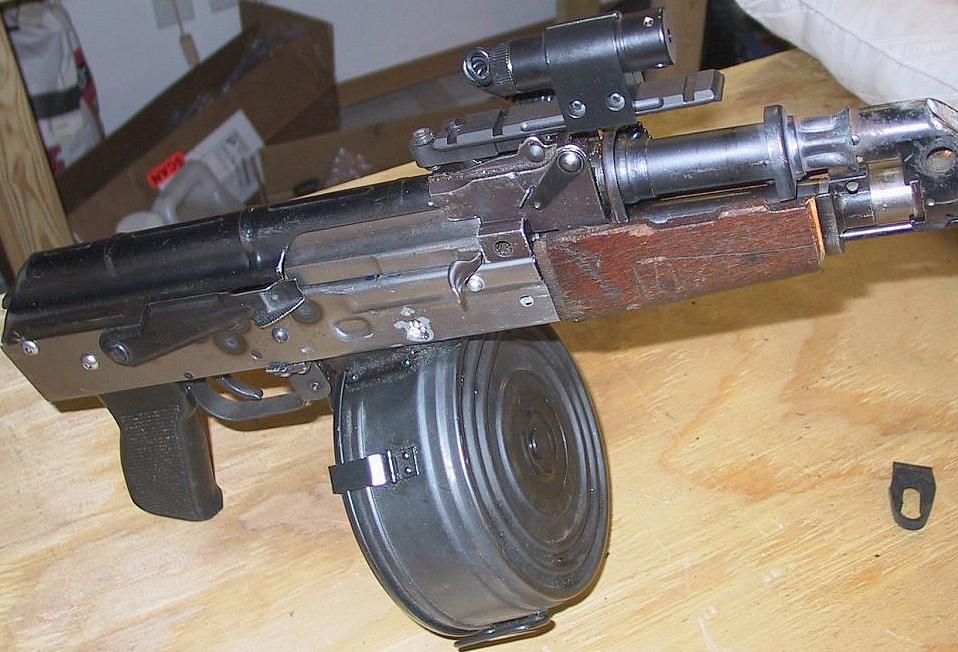
The most considerable collection of experimental and standard small arms, developed by Mikhail Kalashnikov during 1942-1990, is kept in the Military Historical Museum of Artillery, Engineer Troops and Communications in St. Petersburg, the oldest military museum of Russia, until 1964 generally known as the Artillery Historical Museum.
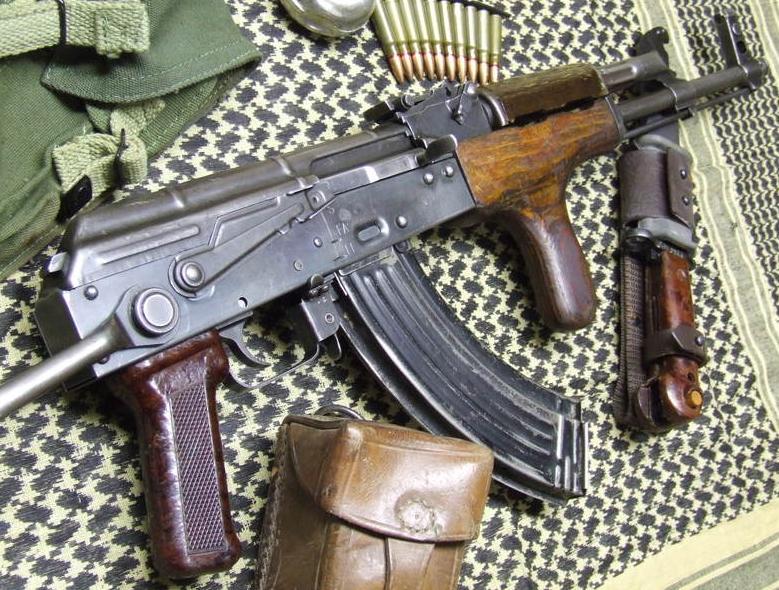
The collection was saved by the museum, thanks to the persistence of the Main Ordnance Directorate command. A considerable reduction of the Soviet Armed Forces in 1959 led to the abandonment of the Research Small Arms Range, where all innovatory models of small arms for armed forces had been tested from 1920. The collection of small arms devised by Soviet designers between 1920 and 1959 was contributed to the fund of the Artillery Historical Museum in Leningrad. Naturally, the museum collected all standard models of the Kalashnikov system, which became operational in the Soviet Army in the period of 1949-1980. The Museum also collected all Kalashnikov systems and modifications adopted and manufactured abroad. However, today things do not look so promising. Only 31 models out of a variety of previously and currently world-produced modifications of Kalashnikov automatic small arms have been collected.
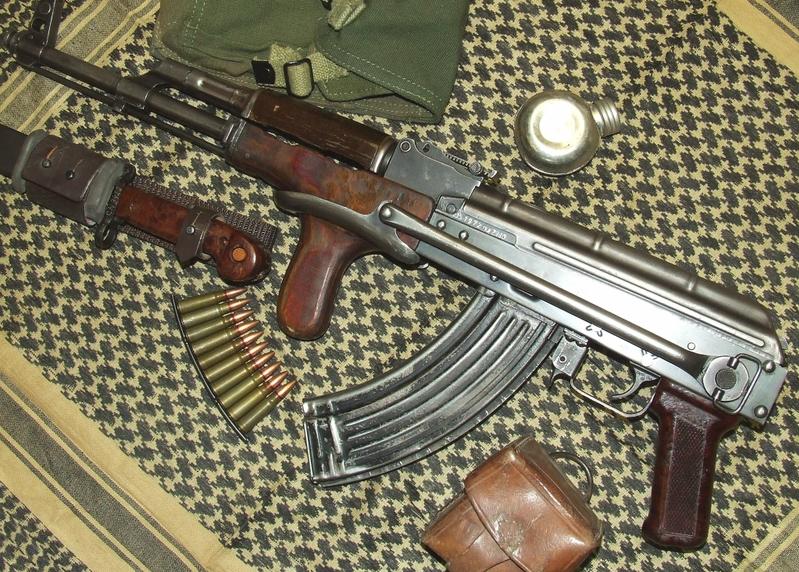
A second collection amassed at the Izhmash JSC in Izhevsk, where Mikhail Kalashnikov has headed a design bureau since 1949. The Izhevsk collection comprises mostly systems developed by Kalashnikov after 1960.

The Izhevsk Kalashnikov Museum opened on 4 November 2004 in Izhevsk, a city in the Ural Mountains of Russia. The museum has focused backward in time. It chronicles the official biography of General Kalashnikov, from his childhood to proletarian hero. The Museum Complex of Small Arms of M. T. Kalashnikov, a series of halls and multimedia exhibitions devoted to the AK-47 assault rifle and its offspring. The museum complex has been drawing on average 10,000 visitors a month. The museum serves as Russia's monument to an infantry weapon and to the workers who have made it for almost 60 years.

It presents the guns and their history with civic pride and a revived sense of national confidence. Think of Izhesvk as the Detroit of Slavic small arms. The exhibitions, ranging from static displays of weapons to plasma-screen video presentations showing the guns' use in recent decades, reflect a laborer's affection for what has long flowed from nearby foundries and assembly lines. Much of the material is also viewed through the life of Gen. Mikhail T. Kalashnikov, the man credited with designing the weapon in secret trials in 1947, and who still lives a few blocks away. Were you to substitute automobiles for firearms and add a bit of military décor, this might be a museum celebrating Henry Ford.
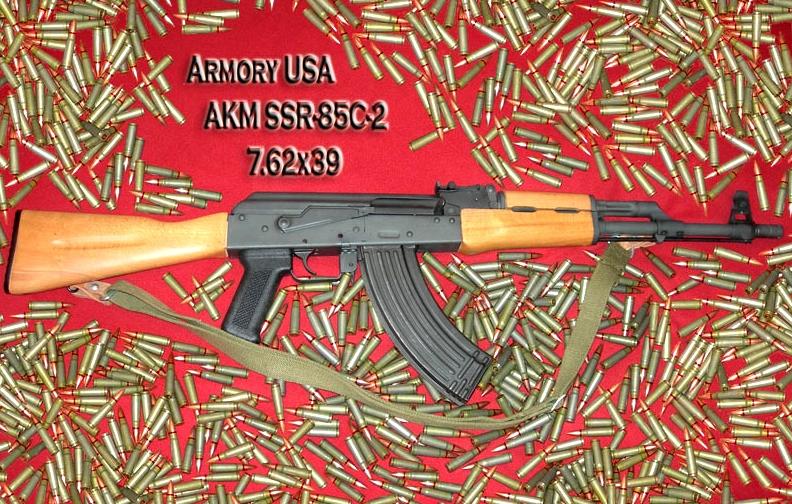
"We emphasize the peaceful side of this story," said Nadezhda Vechtomova, the museum director. "We are trying to separate the weapon as a weapon of murder from the people who are producing it and to tell its history in our country."
AK47: the open-source weapon that took the world by storm
By Lewis Page and Scott Snowden (2007)
Sixty years ago, a former tank sergeant named Mikhail Kalashnikov submitted an assault-rifle design to the Red Army for trials. It was selected as the new personal weapon for most Soviet soldiers, and designated Automat Kalashnikova 1947 - AK47 for short. That designation went out of official use in 1959, but to this day "AK47" is probably the world's most widely-known gun name. Just as open-source Linux - the "communist" software, according to Steve Ballmer - has made Linus Torvalds famous, the genuinely communist open-source AK has given Mikhail Kalashnikov (http://www.theregister.co.uk/2007/08/03/reg_meets_kalashnikov) a profile at least as high. The AK47 and its successor designs are the most widely-used firearms on the face of the planet.
The ubiquitous AK has been seen as one of the most influential pieces of technology produced in the 20th century. People have made amazing claims for it: the Kalashnikov is said to have humbled US military and economic power, to have liberated the downtrodden and oppressed, to have changed the very face of warfare. Dozens of books have been written about the AK phenomenon, hundreds or perhaps thousands of articles.
Only one thing has been lacking in the AK discussion. That is, analysis from the debatable borderlands where technology, social phenomena and enormous, rumbling, erratically-researched commentary/analysis spitball articles collide: the land of Vulture Central. But today it shall lack no more. The Nazis were arguably the first to field an assault rifle in significant numbers, but they dropped out of the picture in 1944. The Russians didn't: which is where Mikhail Kalashnikov and the AK47 come in.
By the end of World War Two, the Red Army had become enormous. Its millions of short-service, poorly trained conscript soldiers were largely armed with cheap submachineguns (sic) knocked out in a hurry. As the Soviets squared up to the Western powers, they knew that their troops - and those of their client nations - would need better weapons. They decided on an intermediate-power cartridge, so as to minimise costs and maximise capability. Having a very low level of marksmanship among their forces, they weren’t much concerned with accuracy or range.
The design they chose was the AK47, firing intermediate power Soviet 7.62mm cartridges, and it couldn't have fulfilled the requirement better. The AK could hit targets out to perhaps 200-300m. (AK47 sights are adjustable to 800m, later increased to 1000m on the AKM, but this is wildly optimistic.) The new weapon could spray bullets efficiently on full automatic, seldom suffering a stoppage. It was simple to strip and maintain, and worked pretty well even without any maintenance, covered in mud, dirt or rust. Best of all, it could be made very cheaply and easily.
Small AK cartridge compared to a 30-06 typical hunting cartridge
The AK47 was a solid design to begin with, and it was continuously developed. The design was refined in 1951, and again in 1959. Strictly speaking, Russian AKs after 1959 were no longer AK47s but AKMs - Automat Kalashnikova Modernizirovannyj (Modernised). The AKM isn’t much different from a classic AK47 as far as the user is concerned, but it's even cheaper to make.
Kalashnikov and his successors did an excellent job on the AK, but even so it has its faults. It's less accurate than an assault rifle really should be; in many cases only a little better than a submachinegun. The safety catch/selector switch is comparatively difficult and noisy to operate: and the bolt doesn't lock open when the magazine is empty, so that a round must be chambered manually after each reloading. For the user, the AK is good-enough rather than actually good.
The AK is Popular
So why is it so wildly popular, manufactured and used in the scores of millions? And why do people attribute such legendary qualities to what is, in the end, a very basic piece of kit? It isn’t at all uncommon to find people saying that the AK47 was a big factor in America’s Vietnam defeat, or that it freed various oppressed peoples from colonial dominance. Commentators - usually journalists rather than gun nuts or soldiers - have suggested that the "People’s Gun" is some sort of phenomenon in its own right, that handing a Kalashnikov - only a Kalashnikov - to a barefoot peasant (or even a child) makes him or her miraculously capable of defeating expensively trained and equipped professional soldiers.
One factor here is probably that the AK was an early example of open-sourcing. The Soviets published full technical and manufacturing specs to friendly countries worldwide, requiring no payments or licensing. The Eastern-European Soviet bloc states all made their own, and the Chinese churned out enormous numbers. The so-called "AK47s" used by the Viet Cong and People’s Army of Vietnam against the Americans were usually - strictly speaking - the Chinese Type 56 copy, and this has often been the case elsewhere as well. Some analysts reckon that the Type 56 is actually the most widely-distributed AK variant. If you got shot by Charlie in 'Nam, he was probably using one of these.
Another reason that the AK established such an early dominance is that for a long time it was the only true assault rifle widely available. In the years immediately after World War Two, America essentially rejected the assault rifle concept. US forces had fought the war with a variety of personal weapons, including a semi-automatic carbine which was very close to being an assault rifle. However, the arm which found favour with post-war US generals was the M1 Garand, a full-power rifle of the semi-automatic or "self-loading" type - ie, it fired one shot per trigger pull without any need to work the bolt manually.
Perhaps reasoning that the German "assault rifle" concept couldn’t have been so all-fired clever or the Germans would have won the war, the Americans compelled NATO to adopt a standard rifle cartridge which was basically an old school full-power rifle round. This was NATO 7.62mm, the same calibre as the ammo for the AK but much more powerful. The Americans modified their M1 Garand slightly to take this new ammo, renaming it the M-14, and carried on happily for another decade or so. Various new kinds of rifle were designed in Europe to use the new NATO 7.62mm cartridge, including refined versions of the original Nazi MP/StG-44, but these were by necessity fairly long, heavy, expensive and potentially accurate to quite long ranges. They are usually called "battle rifles" rather than assault rifles. One of the most famous is the Belgian FAL, known in British service as the Self-Loading Rifle, or SLR.
M-14
Battle rifles were still over-spec’d for the marksmanship skills of the average professional soldier, let alone those of the average conscript, guerilla or insurgent, and they were still a bit long and heavy for closeup scrapping. Furthermore, they were pricey compared to AKs: and neither they or their ammo were widely available. They could be - often were - made under license by foreign factories, but this cost money and was sometimes forbidden by Western governments.
For twenty years or so, then, the AK was the only true assault rifle made in any numbers. It was also the only modern personal weapon of any kind available cheaply and freely to a large proportion of the world’s combatants. As it happens the AK is a more than decent design, but whichever rifle the Soviets chose in 1947 to fire their new intermediate cartridge would probably have become near-universal in these circumstances. Mikhail Kalashnikov didn’t exhibit any genius-like skills; his design didn’t change the world of itself (sic).
Eventually the Americans, embroiled in the jungles of Vietnam against AK-toting commies, decided that they liked controllable automatic fire more than long range after all, and adopted an intermediate-power cartridge at last - NATO 5.56mm - and a true assault rifle to fire it from. The new gun was based on the AR-15 pattern but became much more widely known under its US military designation, M-16.
M-16
The M-16 had terrible teething troubles, which served to further enhance the reputation of the AK. Rumours circulated that the M-16 didn’t need cleaning, supported by the fact that it was initially issued without a cleaning kit. Unfortunately, the Pentagon had chosen to use a non-recommended propellant powder in the 5.56mm ammo, which was especially prone to clog the guns up. On top of all this, as the Vietnam War progressed and the M-16 came into widespread service, the morale and commitment of US troops - mostly unwilling two-year conscripts with no desire to fight or to be good soldiers - plunged to rock bottom.
Unsurprisingly, by the time the less dope-addled American grunts began cleaning their rifles again and the cartridge powder got sorted out, the M-16 had a frightful rep for unreliability. This is where the legend of the AK probably got its first real start, as various Western soldiers and commentators derided the new American "Mattel Toy," and lauded the AK. Interestingly, the Russians themselves didn’t entirely agree. In 1974, the year before the fall of Saigon, they came out with a new version of the AKM, designed to take a new, small-calibre intermediate round - 5.45mm Soviet, not dissimilar to 5.56mm NATO. Thus, the commies had effectively admitted that US small-arms technology was superior to the AK as it then stood.
Small-calibre intermediate rounds like these are said to be just as lethal as old-style 7.62mm Soviet, and they weigh less; which allows more to be shipped and carried. Ever since, the main army rifle of the USSR and then Russia has been the AK-74. Kalashnikov’s design lived on - the AK-74 is still a very recognisable AK descendant - but the famous AK-47 had effectively been superseded, just as it was gaining worldwide fame.
Meanwhile, the allegedly rubbish M-16 went from strength to strength. M-16s in one form or another are still almost universal issue for the US forces and many others. Even more tellingly, M-16 variants are the most commonly chosen assault rifle of Western special-forces units, including the British SAS and SBS. These people are able to select any weapon they like, almost regardless of expense; the M-16 wouldn’t be on their shopping list if it wasn’t one of the best designs available. (Though it’s also quite true that the sneaky elites will frequently carry AKs. This is typically more from a wish to avoid being recognized than because of the weapon’s merits.)
Despite the introduction of the AK-74 in Russia and the fact that the M-16 is actually pretty good, the legend of the original Kalashnikov refused to die. In fact it grew and spread throughout the world, to the point where no other gun has the same degree of recognition. The new 5.45mm Soviet ammo never became as widely available as 7.62mm Soviet, and the AK-74 never really took off globally the way the AK-47, AKM and their various copies did, though Osama bin Laden seems to personally favour the cut-down AKS-74U. To this day, if a Western - or a Russian - soldier gets hit by an enemy bullet, it will normally be a 7.62mm-Soviet round from an old-school AK. Osama is often pictured with an AKS-74U stubby.
In keeping with open-source principles, Mikhail Kalashnikov never made any money from his design directly, though he did gain the rank of General.
Since retirement, he has also lent his name to the marketing of "Kalashnikov" branded vodka, presumably planned to sell at an inflated price in the same way that Porsche sunglasses or Ferrari man-perfume does. The good General gave us his thoughts on Vodka, guns and Russian courage, which you can read here (http://www.theregister.co.uk/2007/08/03/reg_meets_kalashnikov).
The amazing, continued escalation of AK47 hype has certainly not gone away. There have been at least two books just in the past couple of years, and authors or reviewers have described the sixty-year-old shooter as "the weapon that changed the face of war," "the single most deadly weapon ever produced," "A force in itself," and even "a flamboyant symbol of masculinity," god help us. The national flag of Mozambique has an AK on it.
Flag of Mozambique with AK-47
In classic bonehead style, one American librarian refers to it as "this simple submachine gun ... a superior weapon to the American M-16 ... [which is] an inferior, lightweight machine gun," no doubt causing many an eye to roll among the gun-dweeb community.
Izhmash, the commercial arms concern descended from the Soviet small-arms apparats, nowadays holds rights to the AK designs. Like General Kalashnikov, the firm has given up the old-school open source philosophy of communist days, and is engaged in attempts to get licencing income from overseas. The Russian weaponeers, after failing to win any wide adoption even in Russia for the overly-fancy new AN-94 in the 1990s, have now bowed to the inevitable and are once again offering basic 7.62mm-Soviet AK-style weapons for export and licensing.
Note from my friend "Buschmaster:" "the AN-94 wasn't meant to replace the AK-74, they knew it wouldn't because it cost 4-5 times as much to produce and requires a lot more training to use and maintain. Its purpose was for spec ops units, not even intended for sale outside Russia." See Buschmaster's fantastic article on the AN_94 by clicking here.
Venezuelan strongman Hugo Chavez last year purchased a hundred thousand "AK-103s," almost indistinguishable from old-time AKMs, and plans to build a factory in Venezuela to make more. This could be seen as socialist fashion triumphing over practicality, but on the other hand a lot of people have never been very convinced about the deadliness of modern 5 ½ mm slugs. Meanwhile, plenty of people all over the world are still settling their disputes with the original article.
The AK-47 isn’t what people claim for it. It’s far from unique; it doesn’t miraculously make peasants into soldiers; it didn’t change the face of battle. Vietnamese peasants would have driven demoralised US draftees back across the sea without it. The horrors of modern Africa, child soldiers and all, owe more to machetes and tribal hatred than to any kind of firearm. Automatic fire isn’t the big deal everyone thinks; competent gunmen normally fire individual aimed shots. But the Kalashnikov is a perfectly good design; and more than that, it’s fashionable. The AK-47 is dead; long live the AK-47.
The AK brand of arms is still the best in the world. A lot of people associate them with Kalashnikov. However, the true story of the machine gun and Mikhail Kalashnikov's role in it is not described anywhere, a lot of experts say. The creation of the machine gun was linked with a lot of talented Soviet fire arms designers, with military engineer Vasily Lyuty, first and foremost.
Vasily Lyuty was born in 1918 in the settlement of Ust-Labinsk of the Kuban region. In 1941, after he graduated from the Red Army Artillery Academy, he was sent for further studies to the Moscow region, together with other excelling graduates. Vasily became the testing engineer of the fire arms test ground. During the war, he was in charge of fire arms tests.
The history of the world-known gun started on July 15th, 1943, when a captured complex - an MP-43 gun and a cartridge - were demonstrated at a meeting of the arms committee. Chief designer Nikolay Elizarov and chief engineer Pavel Ryazanov created the Soviet "interim cartridge " within a very short period of time. The technological support was provided by Boris Syomin. After that, scientists started working on a new fire arms system for that cartridge.
About 15 designers took part in the competition to create the Soviet gun. Kalashnikov's name was not mentioned among them during the first two years. All tests were performed at the Schurovsky test ground on the outskirts of the town of Kolomna. Major Vasily Lyuty was the chief of the test department.
Mikhail Kalashnikov presented his first machine gun in the middle of 1946. According to the final testing conclusion, the gun was considered imperfect and was not supposed to be developed further. Vasily Lyuty said, Kalashnikov asked him for help in order to revise the official conclusion. Lyuty wrote: "I decided that the whole system should be redesigned. I changed the testing conclusion and recommended the machine gun to be developed. An old friend of mine, engineer Vladimir Deikin, took part in the works on the gun later. We were working until 1947, when we finally produced the testing gun. I personally tested the new weapon."
Vasily Lyuty changed the official conclusion and projected 18 fundamental changes. Yet, everyone was hoping for the gun developed by 36-year-old major Aleksey Sudayev. Scientists were testing the third model of the gun, when Sudayev suddenly died. It was Mikhail Kalashnikov, who took his place.
He went to work on the gun to the town of Kovrov. "Vasily Lyuty, who took Kalashnikov under his wing, did not mention either positions or ranks of the people, who took part in the competition," scientist Dmitry Shirayev said. - "However, about 15 machine guns of other designers were tested on the same ground too. Testing conclusions on each of them, including the Kalashnikov gun, depended on Vasily Lyuty, the chief of the testing department. Chiefs are supposed to be on a neutral side according to their status, but they interfered in the matter."
The stages of the competition were closed. Shpagin and Degtyarov were the first to give up, and only three guns achieved the final stage of the competition in January of 1947: ??B- 415 designed by Bulkin, KBP-520 designed by Dementyev and KBP-580 designed by Kalashnikov.
Bulkin was the leader with his gun according to test results. However, the designer had a very malicious temper, he could not come to consent with military men. As a result, the talented designer was dismissed from the competition. Sergeant Kalashnikov was a lot more agreeable v he was always listening to his instructors - the people of higher rank. Kalashnikov took account of all recommendations during the last stage of the tests and won the competition. A special committee concluded on January 10th 1948 - preference was given to Mikhail Kalashnikov's gun, the future AK-47 gun. However, the gun should have been called not AK but LDK - Lyuty-Deikin-Kalashnikov (Deikin was another chief of the testing department).
In his notes Mikhail Kalashnikov wrote: "Vasily Lyuty was a rather talkative man, he liked making jokes, but there was a serious and professional side in all of his jokes."
Vasily Lyuty fell a victim of repression in 1951. He was rehabilitated only after Stalin's death in 1954. At academician Blagonravov's request, Vasily Lyuty returned to the army and to the research institute. In 1965-1957, Lyuty's new works became the base to create an AKM. Later he took part in the development of Strela-1 and Strela-2 complexes.
"Kalashnikov hardly ever mentioned any of his instructors in his interviews and in his book. Only he knows the reason why," Vasily Lyuty said. The scientist died in 1990 after several operations.
People say that Kalashnikov is a trademark nowadays. This is apparently true. This trademark conceals the work and the mind of a lot of talented Soviet inventors.
AK-47 Specifications
Both licensed and unlicensed production of the Kalashnikov weapons abroad were almost exclusively of the AKM variant, partially due to the much easier production of the stamped receiver. This model is the most commonly encountered, having been produced in much greater quantities. All rifles based on the Kalashnikov design are frequently referred to as AK-47s in the West, although this is only correct when applied to rifles based on the original 3 receiver types. In most former Eastern Bloc countries, the weapon is known simply as the "Kalashnikov".
Russia has repeatedly claimed that the majority of manufacturers produce AK-47 without a proper license from IZH. The Izhevsk Machine Tool Factory acquired a patent in 1999, making manufacture of the Kalashnikov rifle system by anyone other than themselves illegal. However, nearly one million AK-47 assault rifles are manufactured illegally each year. In some countries that are recovering from war or that are at war, prices for AKs are very low. In Somalia, Rwanda, Mozambique, Congo and Ethiopia, among others, prices are between $30-$125. After the Soviet retreat from Afghanistan, the Soviet Army left huge quantities of weapons including AKs which were used in its civil war between Taliban and Northern Alliance and were also exported to Pakistan. It is now also made in Pakistan's semi-autonomous areas. It is widely used by tribes in Africa like the Hamar, amongst others.
During the Cold War, the Soviet Union, Communist China and the United States supplied arms and technical knowledge to numerous client-state countries and rebel forces. This period saw the export, sometimes free of charge, of AK-47s by the Soviet Union and Communist China to pro-communist countries and groups such as the Nicaraguan Sandinistas and Vietcong. The AK design was spread to over 55 national armies.
The proliferation of this weapon is reflected by more than just numbers. The AK is included in the flag of Mozambique and its coat of arms. It is also found in the coat of arms of Zimbabwe and East Timor, the revolution era coat of arms of Burkina Faso, the flag of Hezbollah, and the logo of the Iranian Islamic Revolutionary Guards Corps. "Kalash", a shortened form of "Kalashnikov", is used as a name for boys in some African countries.
At least 82 countries currently list AK or AK-derived assault rifles within their state arsenals. The next most popular assault rifles are the Heckler and Koch G3, originally from Germany, and FN Fal assault rifles, originally from Belgium. These are listed as in use in approximately 50 and 65 of the world’s armies respectively. This is followed by the US-produced M-16, currently listed as in service in up to 42 countries.
In terms of actual numbers of assault rifles produced, the AK outstrips the US- produced M-16 assault rifle by a factor of ten to one. Global estimates put the production of AK rifles in the region of 50-70 million, although estimates of 100 million are not uncommon. By contrast, world production of G3 assault rifles, the next most prolific assault rifle, is believed to be between 15 and 20 million, and M-16 assault rifle production is estimated to be between 5 and 7 million.
The AK-47 has become a popular gun at the family shooting range in the USA.
Demand in many parts of the world for Kalashnikov assault rifles remains strong, not least because the price remains relatively low. Unlike the price of other global commodities such as oil and gas, copper and zinc, the price of a Kalashnikov continues to fall in real terms, aiding its proliferation in poverty-stricken regions of the world. The price of an AK-47 derivative varies depending on sale location, quality, and quantity. A brand new Kalashnikov from a Russian factory costs around $240, depending on the derivative and size of the purchase. In Africa an AK-47 can be bought for around $30 in areas where supplies are plentiful. Thousands of Jordanian Kalashnikovs were bought by the US for the new Iraqi security forces retailed at approximately $60 each. Stockpiled Balkan AK-47 variants cost US and European buyers between $50 and $100 per rifle.
One significant buyer of Kalashnikov rifles and ammunition in the last two years is the US Department of Defence. The EU-led peace-keeping force (EUFOR) in Bosnia and Herzegovina (BiH) and the Organization for Security and Co-operation in Europe (OSCE) state that more than 350,000 AK-47 rifles and derivatives were transferred out of BiH and Serbia and Montenegro by a chain of private contractors operating on behalf of the US Department of Defence between 2004 and 2005, purportedly destined for Iraq. Both the NATO force (SFOR), and subsequently EUFOR in BiH, authorised the transfer of such weapons and associated ammunition via intermediaries to Iraq.
An unknown number of such weapons and ammunition were also shipped to Afghanistan. Private contractors include a network of brokers and shipping agents operating in the USA, UK, Germany, Croatia, Serbia, Moldova, and Switzerland. This list excludes shipments made from Albania, Bulgaria, Slovakia, Slovenia, and Estonia which have either sold or donated AK-47 derivatives purportedly delivered to the new Iraqi and Afghan security forces.
The UK is also a storage and distribution centre for Kalashnikov weapons from the Balkans. In May 2006, it was reported that over 20,000 Kalashnikovs have been imported into the UK by three UK companies: York Guns, Jago (UK) Ltd, and Procurement Management Services Ltd. Documentation issued by EUFOR peace-keeping forces in Bosnia shows that these inter-related UK companies have been involved in the procurement of thousands of weapons from Bosnian stockpiles. One of the directors of Jago is the owner of Transarms, a German gun dealership that trades in large quantities of AK-47 ammunition and other items. Since such military specification weaponry cannot be sold on the UK private internal gun market (current UK law forbids the private ownership of an AK-47 rifle), it is assumed that such weapons must be for subsequent re-export. York Guns’ manager has denied purchasing the Kalashnikov rifles from Bosnia.
With the production of new variants, including the new Russian AK-100 series, the demand for Kalashnikov rifles is likely to remain strong in the future, with many producers also now offering the weapon in NATO calibre for export markets. Evidence suggests that the Kalashnikov 7.62 x 39 mm calibre assault rifle will remain the dominant military assault rifle in many of parts of the world at least for the next two decades and probably longer.
New Russian AK-100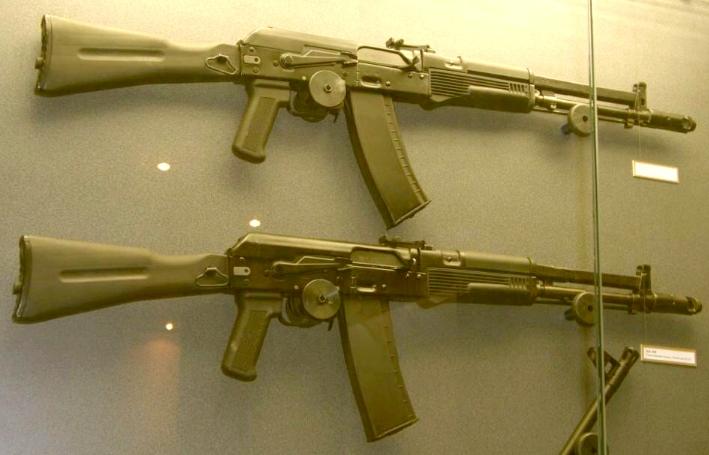
Venezuela has recently signed production contracts for large numbers of Kalashnikov weapons. In June 2005, Jane’s Defence reported that Venezuela had ordered 100,000 Kalashnikov AK-103 assault rifles in a US$54 million deal. The deal also involved assembly of the weapons in Venezuela, adding another production centre for the Kalashnikov, its first in the Americas. In June 2006 it was reported that an initial batch of some 30,000 weapons had been delivered. The deal has caused controversy in the USA, as the US government believes that weapons produced in Venezuela may end up in the hands of Colombian rebels. Kalashnikovs have been supplied to Colombian rebels before from within the region; in 1999, under a deal involving corrupt officials in Peru, more than 10,000 AK-47 derivatives brokered from Jordan were diverted to FARC (Revolutionary Armed Forces of Colombia) guerrillas in Colombia, who are documented as serious human rights abusers.
As a battlefield infantry weapon, the Kalashnikov falls well within accuracy specifications for assault rifles. Its reputation for poor accuracy can be attributed to its widespread misuse rather than any production or design fault with the weapon itself. Many armed groups that use AK weapons are inadequately trained. Also at fault is the usually poor quality ammunition which is often very old and procured from vast surplus stockpiles in Eastern Europe and elsewhere. Key Kalashnikov variants include: Albanian Type A, B, and C; Bulgarian AR-M1 and AR-SF; Chinese Type 65; Hungarian AKM-63 and AMD-65; Iraqi Tabuk; North Korean Type 58 and 68; Poland’s AKM Kainek and Tantal; Romania’s AKM 63 and 65, and the Serbian Zastava M70.
The first full-auto AK's reaching the USA would have come back with Vietnam veterans starting around 1967. Comercial import would have been the early '80's. First the Valmet, then Maddi, Poly-Tech/Norinco, & FEG. (FEG SA-85's were imported by Kassner Imports. Mitchell Arms brought in the first Zastava weapons in 1986.
Viet Cong Soldier with AK
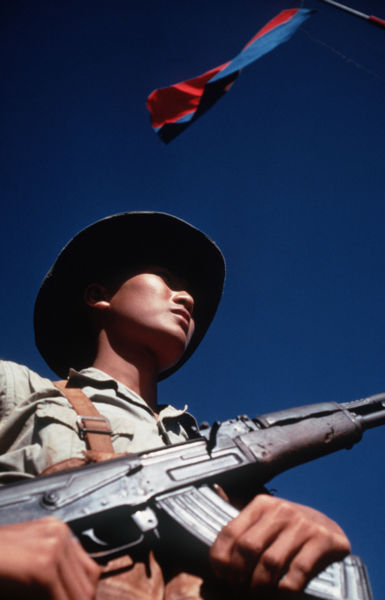
The very first semi-automatic-only Kalashnikov to reach the USA was the Valmet Valtion Metallitehtaat (or State Metal Works) M62/S, imported from Finland by Interarms in Alexandria, Va. Based upon the third model AK-47, the M62/S was a decided marketing failure in the United States...By the mid 1970's, Finland introduced an AKM-type rifle with a pinned and riveted sheet-metal reciever. Designated the M62-76, it was also imported in semiauto-only form as the M-76...Designated as the "ARM" (Automatic Rifle Misr), a semiautomatic-only version of the Egyptian AKM was introduced to the American public in 1982 by the U.S. division of Steyr-Daimler-Puch in Styer, Austria. For all intents and purposes this is as close as most of us will ever come to a Russian AKM." (from Kokalis in Shotgun News)
The MAK-90 semi-automatic "sportster" model deserves a special mention because more MAK-90 rifles were imported from China into the USA than any other model of AK type rifle from any other country. The model name MAK-90 stands for Modified AK-1990. This was because AK rifles with pistol grips, folding stocks, threaded muzzles and bayonets were banned from importation to the USA in 1989.
MAK-90 semi-auto sportster version of the AK-47
The first AK rifles imported in 1990 after the ban were modified by replacing the the pistol grip and stock with a one piece wooden thumbhole stock. The threaded end of the barrel had a muzzle nut screwed on to cover the threads and some were tack welded on. The bayonet lug was ground down so a bayonet wouldn't lock on. The model name was ground off and the modified rifle had the new model name MAK-90 stamped on them. Some had 90 added to the serial number that denoted the year of import. The MAK-90 rifles imported after 1990 had the threads on the muzzle turned off and a 2 digit year of import stamped in front of or in back of the serial number. Some have a space or dash between the serial number and 2 digit year of import stamping. There were a half dozen or so companies that imported MAK-90 rifles. The importers company name, city and state will be stamped on one side or the bottom of the receiver. Some had it stamped on the barrel between the gas block and front sight.
All MAK-90 rifles have stamped sheet metal receivers except for one lot of rifles imported in 1993 that had receivers milled from a solid block of steel. The two types of receivers can be distinguished from each other easily because the stamped receiver has rivets holding it together and the milled receiver has no rivets.
The MAK-90 has a larger diameter barrel,1.5mm thick stamped sheet metal receiver and the double hook disconector of the Ak-47. Other models of AK rifles imported from other countries with the same length barrel have smaller diameter barrels,1mm thick stamped sheet metal receivers, and the single hook disconector of the AKM rifle. The front sight of the MAK-90 has a fully enclosed hood/sight protector with a hole in the top and a smooth receiver cover of the AK-47 Vs. the sight protector that is open on the top and ribbed receiver cover of the AKM.
For all intends and purposes, the original Chinese Type 56 (Legend) are copies of the Soviet AK-47 Type III, these are the so called "Legend" models. When the Sino-Soviet relations went South, the Chinese didnt' get the specs for AKM. What they did was to make up their own stamped receiver to achieve the same purpose. They still called these stamped AK "Type-56", but it has several differences from Euro Pattern AKM. They used 1.5mm stamping instead of 1mm, used a different rivet pattern on trunnion/barrel, and they retained most of the AK-47 parts, such as heavy barrel and front sight. Some also had underfolding cruciform bayonet under the front sight, as the stamped Poly-Tech had.
When the Sino-US relations improved in the late 70s and early 80s, the Chinese started to export their AK to the United States (starting in 1983?). While there were a number of exporters, there are 2 major players, PolyTech and Norinco. Their "Legend" model are milled AK-47 Type III cousins, and the AKS-762 model which are stamped AKM cousins with underfolding bayo. Both models come in underfolding stock as well. Most of the PolyTech's were stamped "386" probably a designation of the arsenal factory. Keng's Firearm in GA seems to be only US importer. There were a bunch caught in customs when '89 ban was signed. These were released after 6 years, had muzzle nut welded, underfolding bayo cut off, and stock swapped to Choate thumbhole stock. There were no official postban models imported into the US after '89.
Polytech AK-47 from 1989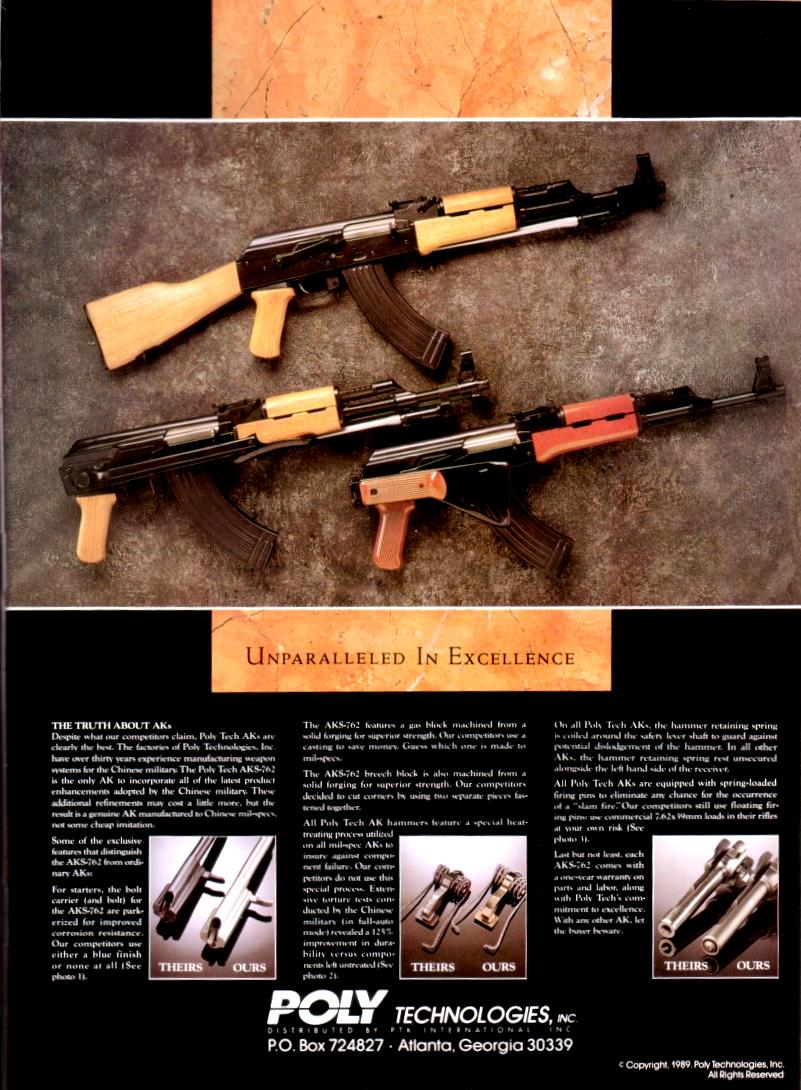
NORINCO, or Northern Industrial Company, is the commercial arm of the Chinese Army, the PLA (People's Liberation Army). Norinco sells conventional arms in every category, from small arms, mines, rockets, anti-tank/anti-ship/anti-air missiles, armored vehicles, to even short/medium range land-based missile systems. Their exports tend to be of a lesser quality than PolyTech, probably due to the volume of AKs they make each year. Technically Norinco AKs are closer to "military exports" than PolyTech, since these were made along side of the full auto military versions they sell to foreign nations. There are 3 basic kinds of Norinco in 7.62. Type 56 full stocked, Type 56-1 underfolding stock, and Type 56-2 side folding stock. All three variants use the Euro pattern bayonet. There's also the Type 84 which use 5.56mm NATO. These were aimed at exporting to countries already using the 5.56. There's also a Type 88 using 5.45mm that Norinco tried to market in the US. The '89 ban stopped these from coming in, but very few dealer samples got in. After the '89 ban, Norinco started to export MAK-90 (Modified AK), and NHM-91 (Nation Match) models in thumbhole stocks. This continued until '94 when Clinton banned all AK/SKS variants from China.
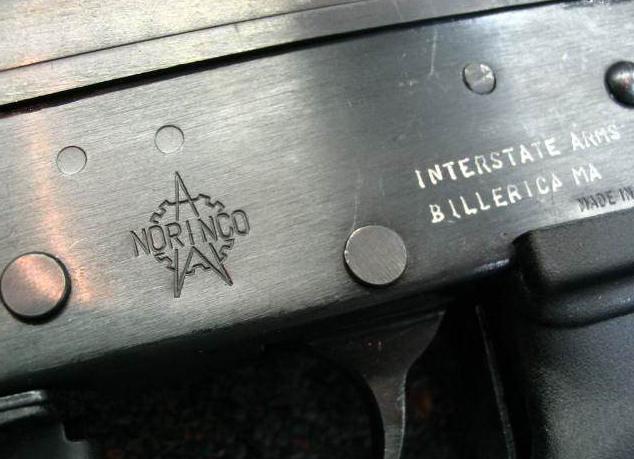
The MAK-90 rifles were imported in cardboard boxes with a one piece styrofoam insert that had cut outs for the rifle and accessories. Each rifle came with three 5-round magazines, a cylindrical buttstock cleaning kit, gas port cleaning tool, cleaning rod, sling and manual. The first rifles imported came with three 30-round magazines, bayonet and a metal piece to attach the bayonet to a belt. Most of these rifles had the 30-round magazines and bayonets removed from the boxes by the importer or dealers. This is the reason that the early imported rifles had cut outs in the styrofoam insert for these items.

The fit and finish on these rifles is very good and the trigger pull is smoother than most other models of AK rifles imported from other countries. The only drawback to these rifles is the uncomfortable Chinese mfg. thumbhole stock. The grip area is quite thick, which makes it difficult to grasp, and reach the trigger with your finger comfortably. This can be adjusted with a little light carpentry work. MAK-90s are well-made, durable and as accurate as any other factory produced AK model.
There are many websites devoted to information and discussion of the AK-47, and some are listed below:
Detailed Disassembly with Photos (2 Pages)
Dr. Zero's AK Manuals (PDF Format)
AKs Type I, Type 2, Type 3 and AKM Chronology and Photos
AK-47.US
Kalashnikov AK
Cruffler.com presents a biography of Kalashnikov and the AK-47
Cruffler.com Part Two about Kalashnikov and the AK-47
Kalashnikov Autobiography (Only One Chapter)
The AK-47 and AK-74 by J.A. Freeman
J. A. Freeman's Page on AK Ammo
History of AK-47 with Photos
The Most Influential Rifle in History (by Gunho Cowboy)
Polytech Legend from China (1989)
Biography of M. Kalashnikov
AK-47 Forums at Gunsnet
The AK Forum
Choosing the Right Magazine for Your AK-47
Magazine Photos
Photo Gallery in Historical Order
Numerous AK Videos
Even More AK Videos
Wikipedia Article
Summerhill on Building an AK-47
Weapon of Mass Destruction, Kahaner (2006)
AK-47 vs M16 on Wikipedia
Avtomat Kalashnikov-1947
AK-47 Museum Virtual Tour
Assault Rifles and Their Ammunition
Buschmaster's Review of the AN-94